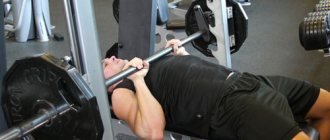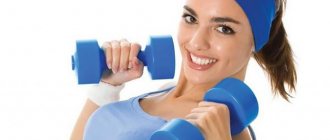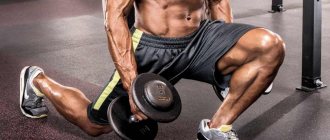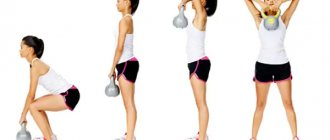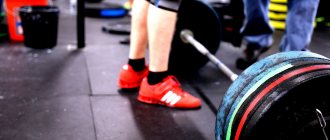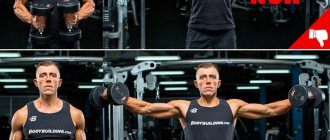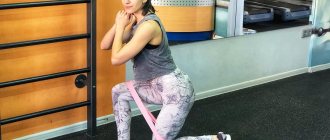The biceps, or biceps brachii muscle, is responsible for bending the arm at the elbow. Developed biceps give the arms a sporty appearance, which is very important not only in bodybuilding, but also in fitness in general. Biceps training is often done using various weights, primarily barbells and dumbbells.
Dumbbells are convenient because they can be used both in the gym and at home. Exercises with them are easy to learn and do not require any technical features.
How to pump your arms correctly
Pumping of the arms is carried out in conjunction with the whole body. There is no point in doing exercises only for biceps; the effectiveness will not be very high.
The bulk of the arms is made up of the triceps, so many recommend combining it into one workout with the biceps. The training program should take this point into account, as well as other training days. For example, you should not do the bench press immediately after the triceps, as it will be overloaded and the result will be significantly worse. Training days should take into account the speed of recovery of individual muscle groups and the body as a whole.
When performing arm exercises, you should follow some recommendations:
- to increase muscle volume, you should not perform more than 15 repetitions in each approach;
- 1-3 exercises are enough. It all depends on the athlete’s level of training and recovery speed;
- biceps training can be carried out together with triceps training;
- To increase the volume of your arms, you need to be guided by general recommendations regarding nutrition and regimen.
Important! Raising the biceps exercises is carried out with maximum effort, while returning to the starting position will be slow. The technique will depend on the specific exercise, differing in each case.
Be sure to watch: How to pump up your biceps at home: strong and sculpted arms How to lift the barbell correctly to pump up your biceps Training your chest and biceps: a list of exercises and the nuances of pumping Intensive workouts for growing biceps and triceps
At what rate does biceps grow during normal training?
The growth rate of biceps varies from person to person; it is influenced by many factors: diet, age, intensity and regularity of training, body type, lifestyle and the chosen set of exercises.
In a person of average height and without problems with excess body weight, the increase in the size of the biceps muscle occurs as follows:
- A slight increase in muscle size is observed after 3 months of training, but the first six months are usually spent adapting the body and organism to regular loads.
- After a year, the increase in muscle mass becomes more noticeable; if you follow the basic rules, it can amount to 3 kg.
- After 3 years of active training, the volume of the biceps muscle increases by 5-7 cm.
- After 5 years of training, the growth of muscle mass slows down, the annual increase on average is no more than 5%.
The most effective exercises for pumping
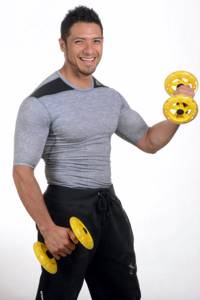
There are a huge variety of biceps exercises with dumbbells. Each of them has its own characteristics, but there are fewer of the most effective ones that suit most athletes.
You need to choose individually; two or three, depending on the training goal, will be enough.
The best exercises are performed with a barbell or dumbbells, but in most cases the equipment is interchangeable.
For example, lifting dumbbells for biceps may well replace lifting a barbell, and vice versa, since the difference in the nature of the load will be insignificant.
standing
The main exercise for biceps while standing with dumbbells is the arm curl. Lifting can be done alternately, as well as simultaneously, that is, with both hands at once.
Lifting dumbbells for biceps should be performed strictly according to the following technique:
- stand up straight, holding an apparatus in each hand. The back is straight, arms along the body;
- lift the dumbbell along the body, turning it so that the palm is initially turned towards the body, and at the top point there is a 90-degree turn;
- lowering the hand is carried out slowly.
Important! There is another option - the hand does not rotate, but remains parallel to the body throughout the entire movement. This exercise is called “hammer”, the emphasis of the load shifts slightly to the outer beam.
Standing with supination
Supination is the turning of the hand. In fact, standing biceps curls with supination are one of the options for performing such an exercise. At the lowest point, the arm is parallel to the body, then rotates 90 degrees.
It is important to understand how to do the exercise correctly. The hand turns slowly throughout the movement, and not at the last moment. The load shifts slightly to the upper bundle of the biceps, the so-called “peak”.
Sitting
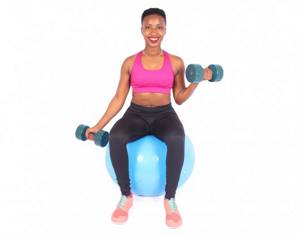
Various biceps exercises can be performed while sitting. A special bench with an adjustable inclination level, as well as a different rotation of the hands, will help you change the emphasis of the load. For example, the exercise can be done with or without supination, on an incline bench or without an incline.
There are several options for seated biceps exercises:
- on an inclined bench;
- on Scott's bench;
- with supination;
- with emphasis on the leg (the angle of inclination changes slightly, the hand rests on the leg just above the knee).
Important! It is worth changing the exercises periodically to give different loads to the muscle. This will ensure the greatest return from your training.
Sitting on an incline bench
The exercise on an incline bench is somewhat more difficult to perform than on a straight bench. This method will provide a concentrated lift while sitting, the load will fall more on the peak of the biceps, as well as on the forearm.
The technique is approximately as follows:
- sit on the bench, having previously set the desired level of inclination;
- lean your back on the back of the bench;
- take a light dumbbell in each hand;
- Raise your arms with effort and lower them slowly.
It is worth increasing the working weight only if it becomes easy to perform more than 12 repetitions, 3-4 approaches with the previous load.
Sitting with supination
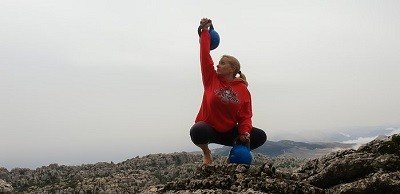
Seated biceps curls with supination are an excellent option for those who do not know how to pump up the entire biceps with minimal emphasis on its individual parts.
The exercise can be performed both on a straight bench and on an inclined one. It should be done in the same way as standing biceps curls with supination, only the initial position of the body differs.
With a turn
Turning around is, in essence, supination. That is, the hand should turn during movement, initially being parallel to the body, and then changing its position by 90 degrees. It is performed in the same way as biceps curls with supination while standing, only the initial position is sitting, with a straight back.
Hammer grip dumbbell lift
The technique for this exercise for biceps with dumbbells is as follows:
- We stand straight with our feet shoulder-width apart. First, take dumbbells of a suitable weight in your hand. We lower them to the sides of the body so that the palms look inward.
- Let's take a deep breath. We bend our arm, tensing the biceps muscle and exhaling at the same time. Try to keep your shoulders still. Raise the projectiles as high as possible so that they are approximately at shoulder level. Fix them for a second at the top point.
- Lower the dumbbells while inhaling. Repeat as many times as necessary.
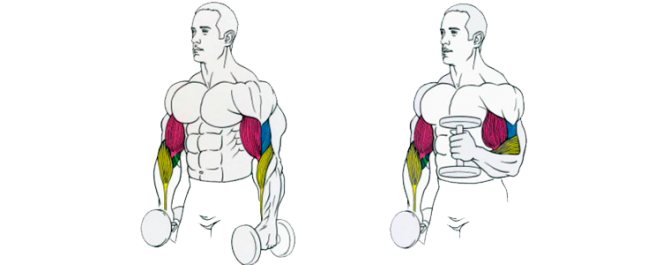
Training program: what exercises and how many approaches to do for maximum effect
At the beginning of classes, it is important to understand how to quickly pump up and pump up its individual parts. Everything will depend on the characteristics of the body, but in any case you will need to create a program that meets the training goal.
If you are working on mass, you need to perform 1-3 exercises of 8-15 repetitions, but if the goal is relief, then the number of exercises will be 3-5, and repetitions need to be done from 15 or more.
Example of a program for ground:
- standing dumbbell curls for biceps, 4 to 12;
- dumbbell raises with supination while sitting, 3 to 10.
An example of a relief program:
- standing dumbbell raise, 4 x 20;
- seated dumbbell raise “hammer”, 4 x 20;
- biceps sitting on an inclined bench, with supination, 3 to 20;
- on the Scott bench with supination, 3 to 15.
The training program should be changed from time to time. For example, you can try combining triceps training by combining exercises into supersets or completely replacing some of the movements with others.
To increase arm volume, one workout per week is enough; if the recovery rate is fast, you can add a second, but no more. It is not recommended for beginners to train one muscle group more than once every seven days. On average, recovery will take this long.
Is it possible to build biceps without dumbbells?
To effectively train the biceps, as well as other muscle groups, several simple conditions must be met.
First, the training should be intense - that is, based on basic multi-joint exercises performed with a large working weight in an average number of repetitions (6-8).
Secondly, it should include isolating exercises aimed at detailed, focused work on the biceps and “finishing it off” after heavy basic approaches. These are, in a general sense, the main components of an effective biceps workout.
Important!
However, beginners who want to exercise at home often ask: how can you build up your biceps without using, for example, dumbbells? It is immediately necessary to understand that barbells, dumbbells and exercise machines are just tools to provide the type of load we need. It is the nature of the load that is extremely important in muscle training, and not the exercises themselves and the equipment used for this. The most important thing is to fulfill the two main conditions that I cited at the very beginning of the article.
For example, as one of the basic exercises for biceps, you can use pull-ups with a narrow reverse grip, and replace dumbbell exercises with exercises performed, for example, with 5-liter bottles of water or sand, and perform isolation exercises with smaller volumes, for example, concentrated lifts. You can also use a heavy bag or backpack. A rubber expander is an excellent tool for isolation exercises. In general, all available means that you can use to ensure the proper level of load.
However, I always advise everyone to sign up for a gym and not waste time on home workouts, which for most beginners do not lead to any results.
This does not mean at all that home exercises are a priori ineffective; it just requires a huge amount of knowledge of physiology and anatomy, as well as many years of experience, to construct them competently.
When you come to the gym, you don’t have to come up with specific exercises for yourself and somehow try to build a full-fledged program out of them - there you will already have all the necessary tools for effective training - barbells, dumbbells, strength training machines with the desired load angle.
Pro Tips
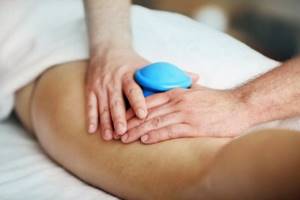
Professionals advise training the biceps along with other muscle groups. There is no need to give the biceps muscle a separate workout; at least it is better to combine it with the triceps in a common “arm day.”
You can train your biceps at home, you will need at least dumbbells. A barbell will help diversify the training process, but a full workout can be done without it.
Alexander Fedorov, bodybuilder
Soviet and Russian bodybuilders are of the opinion that it is better to train biceps with triceps, but other training approaches are also possible, since the program needs to be changed from time to time.
Dumbbells are perfect for developing biceps; there are quite a lot of exercises with which. It is better to start with simple lifts and end with isolating movements, for example, performing a concentrated lift on a Scott bench.
Alexey Lesukov, bodybuilder
Professional bodybuilder Alexey Lesukov claims that biceps exercises with dumbbells are effective, since such equipment can put a load on the biceps muscle as a whole, as well as on its individual bundles, more isolated.
Exercises should be performed sequentially. When we pump up our biceps, we must adhere to the program drawn up in advance. The number of approaches and repetitions will depend on the characteristics of the body and the speed of recovery, as well as the training goal.
Alexander Vishnevsky, coach
Being a successful bodybuilder in Russia, Alexander Vishnevsky also conducts coaching activities. Regarding the biceps, he advises to proceed from the task at hand, as well as the level of training of the athlete.
For example, if a very thin athlete puts a lot of emphasis on his biceps, he will not achieve success. He needs to focus his energy on multi-joint movements, and pump up his biceps after the main workout, performing one or two exercises.
Reasons why biceps don't grow
Some men and women encounter a problem where the biceps muscle does not grow from the very beginning of training or slows down its growth at a certain stage.
This may be due to the following reasons:
- Overtraining of the biceps: after many years of training, the growth of muscle mass decreases, this phenomenon is natural.
- Lack of a balanced diet, eating inappropriate foods and lack of vitamins.
- Monotony of the training process, lack of new exercises for a long time.
- Violation of the rules for performing the selected exercises.
- Too long breaks between classes, their irregularity.
